Читать книгу Hybridized and Coupled Nanogenerators - Ya Yang - Страница 30
2.3.1.4 Others
ОглавлениеTo harvest wind energy in our living environment, Xie et al. produced a TENG based on a rotary‐driven mechanical structure, which consists of a shaft, a flexible rotor blade, and two stators [35]. The triboelectrification and electrostatic induction effects in this TENG can be generated by utilizing a hybridization of the contact‐sliding‐separation‐contact processes. Zhang et al. developed a single‐electrode cylindrical TENG to harvest wind energy, which consists of a cylinder, a cylinder tube coated with PTFE [36]. The electric energy generated by this TENG can be used to power wireless sensors. Bae et al. reported a flutter‐driven TENG based on a flexible flag and a rigid plate and studied three contact modes (single, double, and chaotic) to increase the performance of the TENG [37]. Ren et al. designed a coaxial rotatory freestanding TENG, which consists of a stator and a rotator. The stator was made of an acrylic column coated with polyvinylidene fluoride (PVDF) nanofibers membrane, and the rotator was made of another acrylic tube with Al tapes [38].
The TENG arrays could enhance the efficiency of harvesting wind energy. Quan et al. reported double‐side‐fixed TENG arrays based on the coupling of triboelectric frication and electrostatic induction. The TENG arrays were connected in parallel by copper wires. These TENGs consist of top and bottom PTFE/Ti/Al patches and a vibrational Al/Ti/Kapton/Ti/Al film [39]. To enhance the performance and reduce a typical rigid friction of common TENG for harvesting wind energy, Wang et al. reported a composited structure, which consists of an anemometer TENG based on freestanding mode and a wind vane TENG based on single‐electrode mode [40]. The anemometer TENG was made of wind cups, rotator, and stator. Wind energy harvested through the wind cups can be used to drive the rotator. The FEP film used as a triboelectric surface was coated on the rotator. The wind vane TENG was made of a vane connected with a pie‐shaped rotator and a compass coated with Cu electrodes.
Figure 2.5 Diagram of the elasto‐aerodynamics‐driven TENG. (a) Schematic diagram of the TENG. (b) The front view of the TEG. (c) Sketches illustrating the electricity generation process in the elasto‐aerodynamics‐driven plate‐based TENG.
Source: Reproduced with permission from Wang et al. [34]. Copyright 2015, American Chemical Society.
Wind‐driven generators normally can harvest wind in a single direction, which reduces the efficiency of wind energy utilization. To solve this problem, Zhang et al. developed a flexible and transparent TENG, which can harvest natural wind in discretional blowing directions [41]. The TENG was made of massive freestanding polymer strips similar to a forest morphology. When the wind blows, the strips comprised of indium tin oxide (ITO) with polyethylene terephthalate (PET) thin film could sway independently. Harvesting wind energy at a high altitude is difficult for normal wind‐driven generators. Recently, Zhao et al. reported a woven TENG flag based on the interlaced interactions between the Kapton film and a conductive cloth, realizing collection of high‐altitude wind energy [42]. The conductive belts were made of polyester textiles coated with Ni and Kapton film‐sandwiched Cu belts.
